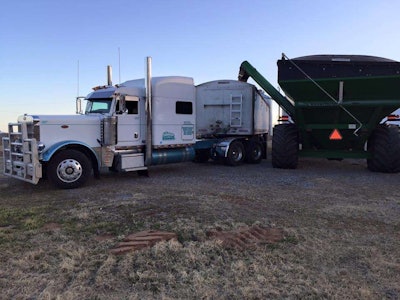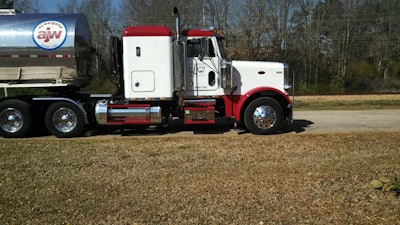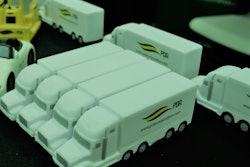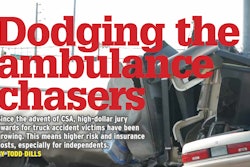 Bill Calwonsen owns three trucks, including this 2007 Peterbilt 379, and pays around $2,600 a month for physical damage coverage for all three rigs.
Bill Calwonsen owns three trucks, including this 2007 Peterbilt 379, and pays around $2,600 a month for physical damage coverage for all three rigs.A typical annual premium for physical damage insurance is 3 percent to 5 percent of the truck’s value, or $3,000 to $5,000 for a truck worth $100,000. A bad wreck or poor motor vehicle record, however, can bump the cost to 8 percent or more – that is, if you still can get damage insurance.
“Typically, the stated value of the vehicle is important, but the driving factor behind premiums is the MVR,” said Courtney Wilson, president of 1st Guard Insurance Co. “We go back three years to see if there are any claims or moving violations. If the MVR is clear, the driver will qualify for our best rate. If there are a couple of knocks, they’ll get a mediocre rate, and if there are too many knocks, they won’t qualify.”
Coupling a good MVR with solid experience and reliable equipment that’s 10 years old or so, she said, will get the best rate possible. “If you’ve have your CDL for more than five years, you’re automatically going to get a better rate than somebody who’s had theirs for two years.”
Likewise, small-fleet owners will save a lot on insurance by hiring experienced, safe drivers.
Bill Calwonsen has noticed the records of drivers he hires have a major impact on his insurance rates. He owns two trailers and three Peterbilt 379s – model years 1994, 2004 and 2007 – and carries his insurance through the Owner-Operator Independent Drivers Association.

Where you typically run also affects rates, said Sentry Insurance’s Randy Ramczyk. “If you’re driving in downtown Los Angeles, Chicago or a heavy metro area, your risk for a collision is higher,” he said. “You’ve also got higher-theft areas like Cook County in Chicago, Miami and really all of Florida, where there are more cargo thefts.”
A typical deductible for physical damage insurance policies is $1,000. The premium savings that accompany a higher deductible usually don’t justify the risk, said Steve Libertore of National Risk Management Services.
“If you don’t make any claims in a year, it could save you a couple thousand dollars, but if you do make a claim or two, you’ve gone beyond those savings,” Libertore said.
Most insurance companies, including OOIDA and NRMS, try to write policies for tractor-trailer combinations under one deductible. That way, if one accident damages both units, the owner absorbs a $1,000 cost only once.
 Craig Benfield has noticed that some insurance companies will argue about the value of an older truck. He maintains just $10,000 worth of coverage on this 1992 Peterbilt 379, which keeps his premium around $660 a year.
Craig Benfield has noticed that some insurance companies will argue about the value of an older truck. He maintains just $10,000 worth of coverage on this 1992 Peterbilt 379, which keeps his premium around $660 a year.Combined deductibles also can be found when bundling coverages such as physical damage and cargo insurance, Ramczyk said. For example, Sentry writes all of its physical damage policies with liability coverage included.
Flatbeds are usually the most expensive trailers to insure, especially if they’re meant for heavy-haul applications and involve multiple pieces. Wilson said a dry van adds about $50 a month to a policy, and a flatbed adds $75 or more.
One tricky part of damage insurance is determining the equipment’s value. Most insurers rely on the owner’s assessment, so it’s beneficial to check with a dealership yearly to get an idea of your equipment’s current worth.
“The worst thing you want to do is have an owner-operator paying for $30,000 worth of insurance and then at the time of loss find out the truck is worth only $26,000,” Libertore said.
With the rising price of new equipment, along with the advanced technology in new trucks, premiums have increased over the last three years, Ramczyk said.
“Replacement of equipment in a total loss is more expensive, so you have to get enough of a premium to cover inflation,” he said.
Craig Benfield, a leased owner-operator, drives a 1992 Peterbilt 379 short hood – “an older truck that isn’t worth as much,” he said. He carries only about $10,000 worth of damage coverage through Great West Casualty.
“With older trucks, it can get to the point where the insurance companies will argue with you on what it’s worth,” Benfield said. “I had to make a claim not too long ago when I hit a deer, and it was more than $5,000 to replace the hood and fix the front end. It was no problem through Great West, and they paid well.”
Libertore said keeping receipts for work and upgrades can help prove to insurers that the truck is worth as much as you claim.
It’s worth evaluating potential addendums for a damage policy, such as for towing or providing a rental truck when yours is down. For some insurers, towing is standard on all policies.
Another consideration is gap insurance, which covers the difference between the value of the truck and the loan balance in the event of a total loss. Ramczyk said lease gap coverage is becoming more common with new equipment that depreciates quickly.










